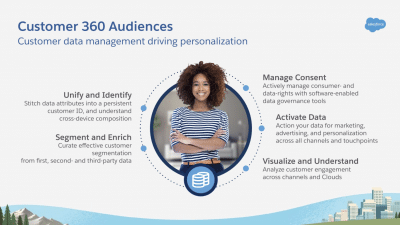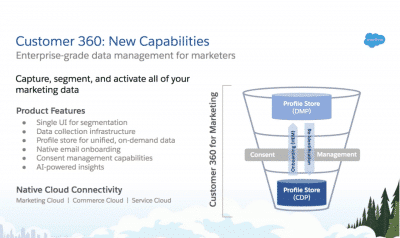Salesforce CDP
Customers have been expecting companies to have a deep awareness of their preferences for a few years now. They also want a high level of personalisation and quick service. They expect all of their online interactions to be reflected in the company’s mobile apps and in-store visits. They expect their experiences to be constant and “in the moment” when they go from channel to channel.
Most customer journeys involve over three different channels (e.g., e-mail, web, and mobile app), and customers tend to move seamlessly and quickly between these channels. The problem is that those environments operate on different datasets — even though the customer is the same.
Most companies don’t have their data environments connected in real-time. It results in disconnected experiences for consumers and the lack of a single source of truth about customers for the marketeer.
The solution for these problems can be found in a CDP platform.
Customer Data Platform (CDP)
A CDP platform connects all the company’s customer data in one place. That means not only connecting a single customer ID from many different CRM instances, but also tying together databases that traditionally don’t share customer data, like marketing clouds, service software, and e-commerce engines. We call that customer resolution.
A CDP brings together the information we have about our known customers (like email and mobile numbers) with what we know about customers before they share their data with companies (anonymous cookies and mobile device IDs, as an example). That allows us to associate an interaction between an email campaign with the company’s website. We think of this as a cross-device identity.
After the CDP has created unified profiles of customers, the system makes that data available in real-time so companies can deliver personalised experiences and fulfil the customer’s expectations. The connection of the data is conducted on many different types of systems – email-send engines, demand-side platforms, and content management systems.
Data collection, data unification, data activation, and data insights are all CDP tasks. A CDP platform consists of a customer database, marketing automation, multichannel campaign management, and real-time interaction management. CDPs have mostly used for all activities baked-on marketing databases with user-level data. To learn more, click here and watch the video.
Why Use a CDP?
1. Data unification
As the number of data sources used by enterprise marketing departments is growing rapidly every year, the most important aspect for marketers is to have a unified view of their customers and the connection of disparate data sources.
2. People-based marketing
‘People-based marketing’ generally means that you manage your customers as unique individuals. In previous years, marketing has been mostly channel-centric or campaign-centric. Although for many organisations, it’s been really difficult to reorient all of their marketing efforts around individuals, it seems to be worth it in the long run. That’s why CDPs will be an integral part of the people-based marketing future.
3. Identity resolution
To perceive the customers as unique individuals, marketeers need sophisticated identity resolution technology. Tying all channels of customer identity together while complying with privacy rules (where your customer knows your actions and approves them) is as complex as it is essential. That’s why identity resolution is a core component of Customer 360.
4. Real-time engagement across channels
Involving customers in real-time is a high priority for marketers, but also their most important challenge. A part of this challenge comes from a misreading of what “real-time” means. Marketers need to collect information about what can be done in real-time and what can’t. For example, you can’t do an artificial intelligence (AI) model in real-time as it takes a long time. However, what you can do in real-time is to do a lookup, force a rule, ping a database, or ask questions based on previous models. However, the aim should not be to do all things in real-time all the time.
What Do We Use CDPs for?
Suppression: A unified profile that links marketing and purchases data and enables marketers to optimise their addressable spend by suppressing consumers that have already made a purchase, and redirecting those dollars towards net-new customers, or recommending other products.
Personalisation: A CDPs make the unified profile available to all addressable channels, enabling personalisation and relevancy. It is psychologically proved that customers who see content tailored to their interests are five times as likely to engage with a brand.
Insights: What makes better marketing? The answer is: knowing the customer desires better. What if an outdoor seller had a customer’s marketing interactions (email and advertising engagement) tied together with their e-commerce data (purchase history) and website interaction data (products viewed multiple times) – and made that information available to a service rep in the call centre? Small data information can release the right product recommendations to the call centre agent, who can prepare a personalised, suitable offer on the spot. Capture, unify, segment, and activate all of your customer data.

Exhibit 1: Customer 360 Audiences – Salesforce
Create a single, consistent customer ID: Unify customer data across multiple teams, devices, and systems, such as email, online behaviour, e-commerce, and CRM data.
Deliver trusted, compliant experiences: Easily manage consumer data and consent with safe provisioning measures and dashboards for opt-outs and consent flags. Automatically comply with new legal standards, like GDPR and CCPA.
Uncover deep insights across channels and clouds: Get a clear view of customers across marketing, commerce, sales, and service interactions, and then optimise live campaigns based on your data.
Build effective customer segmentation: Easily stitch together first-, second-, and third-party data to create and analyse specialised audience segments.
Personalise every interaction: Advertise to the right segments and personas with content tailored across social platforms, online ads, and beyond.
CDP is now Customer 360 for Marketing: Customer 360 is a platform which allows companies to connect Salesforce apps and create a fused customer ID to build an individual view of the customer. Moreover, by enlarging the power of Customer 360 with MuleSoft, companies can connect any app, data source or device across any cloud and on-premise. Nowadays, Salesforce is expanding Customer 360 with new advancements that will enable joining fragmented customer data across the whole organisation and enable companies to deliver integrated customer engagement at scale.

Exhibit 2: Customer 360 new capabilities – Salesforce
The Next Generation of Customer 360 will Enable
Data Unification and Consent Management: It will be possible for companies to unify all of their customer data to create rich customer profiles. This includes all kinds of data – known and unknown. With Salesforce’s consent management framework, companies will be also able to obtain customer consent wherever they engage – from email marketing to digital advertising.
Advanced Audience Segmentation: Segmentation capabilities will allow companies to identify certain groups of people to engage within real-time based on demographics, engagement history and all other customer data available. For example, it will be possible for the company to build an audience of female shoppers who are interested in running shoes based on information collected from a combination of web browsing activities across several retail sites, marketing email interactions, previous purchases and more.
Personalised Engagement Everywhere: If a company knows what customer segment they’d like to reach, it can activate the customer data across marketing, commerce, service and beyond. This means companies won’t lose any information, reaching customers and prospects across channels like ads, email, social, mobile and web that are all joined to deliver a continuous experience with the brand.
Einstein
Optimisation Based on Einstein Insights: With artificial intelligence, it will be possible for brands to analyse and understand how and when to engage with customers to gain customer loyalty and improve business performance. Customer profiles are being updated all the time. It is based on their behaviours – as customers click on an ad, browse an e-commerce catalogue, buy a product and open an email. This lets the companies leverage AI to drive the most suitable mixture of product and channel recommendations to optimise channel engagement and customer satisfaction.
“We have real-time data capture capabilities today, but we also have the vision of integrating a lot of what we acquired with Evergage, which is a real-time CDP, and our roadmap bakes in a couple of different Evergage capabilities which go well beyond batch. The CDP we’re releasing in October has real-time data ingestion capabilities coming from the native integration with Sales, Service and Marketing Clouds.” – Chris O’Hara, VP of Product Marketing at Salesforce.
Customer 360 Audience goal is to unify customer profiles across data. Using customers’ IDs, email addresses, and unknown data, like website visits and device IDs, and powered by AI, the system creates customer segments that can predict things like “lifetime value” or “likelihood to churn” — allowing marketers to optimise the customer experience.
Go to All Downloadables
Contact us